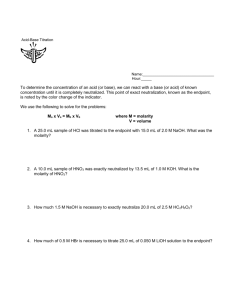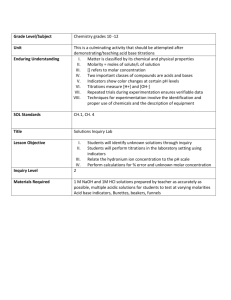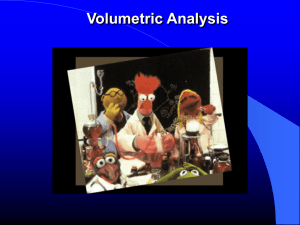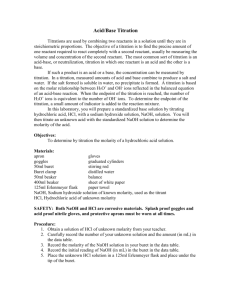Acid Base Titration Lab Exam
advertisement
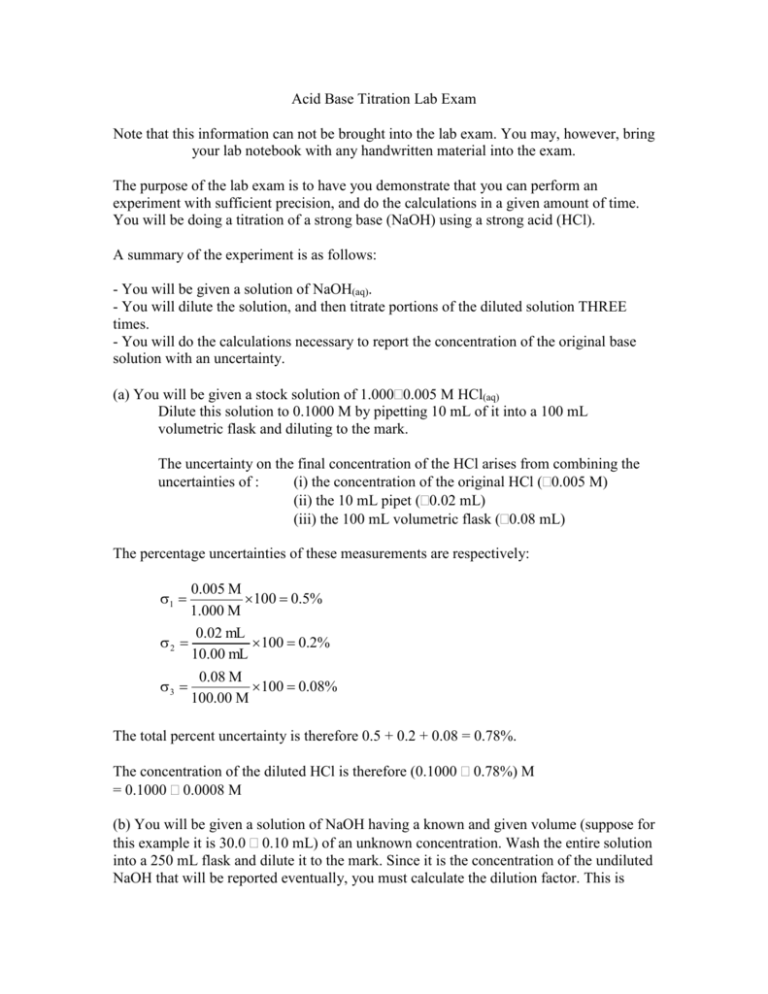
Acid Base Titration Lab Exam Note that this information can not be brought into the lab exam. You may, however, bring your lab notebook with any handwritten material into the exam. The purpose of the lab exam is to have you demonstrate that you can perform an experiment with sufficient precision, and do the calculations in a given amount of time. You will be doing a titration of a strong base (NaOH) using a strong acid (HCl). A summary of the experiment is as follows: - You will be given a solution of NaOH(aq). - You will dilute the solution, and then titrate portions of the diluted solution THREE times. - You will do the calculations necessary to report the concentration of the original base solution with an uncertainty. (a) You will be given a stock solution of 1.0000.005 M HCl(aq) Dilute this solution to 0.1000 M by pipetting 10 mL of it into a 100 mL volumetric flask and diluting to the mark. The uncertainty on the final concentration of the HCl arises from combining the uncertainties of : (i) the concentration of the original HCl (0.005 M) (ii) the 10 mL pipet (0.02 mL) (iii) the 100 mL volumetric flask (0.08 mL) The percentage uncertainties of these measurements are respectively: 0.005 M 100 0.5% 1.000 M 0.02 mL 2 100 0.2% 10.00 mL 0.08 M 3 100 0.08% 100.00 M 1 The total percent uncertainty is therefore 0.5 + 0.2 + 0.08 = 0.78%. The concentration of the diluted HCl is therefore (0.1000 0.78%) M = 0.1000 0.0008 M (b) You will be given a solution of NaOH having a known and given volume (suppose for this example it is 30.0 0.10 mL) of an unknown concentration. Wash the entire solution into a 250 mL flask and dilute it to the mark. Since it is the concentration of the undiluted NaOH that will be reported eventually, you must calculate the dilution factor. This is 250/30 = 8.33 in this example. (You will have to multiply the concentration calculated from the titration by this factor to get the concentration of the undiluted sample.) This dilution factor has an uncertainty from two sources – that on the 250 mL volumetric flask ( 0.12 mL) and that on the volume of the given base solution ( 0.10 mL). The percentage uncertainties are therefore: 4 0.12 M 100 0.048% 250 M 5 0.10 mL 100 0.33% 30.00 mL The total percent uncertainty is therefore 0.048 + 0.33 = 0.38%. The dilution factor is therefore 8.330.38% = 8.330.03 (c) Place 25.00 0.03 mL of the acid into an Erlenmeyer. Fill the burette with the base solution and record the volume to two decimal places (9.60 mL for instance). Titrate the solution using phenolphthalein as an indicator. Record the final volume (3.55 mL for instance). The titration volume is therefore 9.60 – 3.55 = 6.05 mL. Since the uncertaintly on each of the two volumes is 0.05 mL, the titration volume is therefore 6.05 0.10 mL Repeat the titration twice more. Suppose the three titration volumes are 6.05 0.10 mL, 6.15 0.10 mL, and 5.90 0.10 mL. Calculate: The average titration volume: Vavg 6.05 6.15 5.90 6.03 0.10mL 3 The relative spread of the three values: Re lative spread highest lowest 1000 ppt average 6.15 5.90 1000 41 ppt 6.03 (part of your grade will come from the relative spread of your values – the lower the better!) The molarity of the unknown NaOH solution: M1V1 = M2V2 Where M1 is the molarity of the HCl solution used (0.1000 0.0008 M) V1 is the volume of HCl solution used (25.00 0.03 mL) M2 is the molarity of the base solution titrated (remember that the original base solution was diluted to obtain the solution you titrated). V1 is the average volume of base solution used (6.030.10 mL) Thus, M 2 M1V1 0.1000 0.0008 M 25.00 0.03 mL 0.4146 M V2 6.03 0.10 mL And as above, the percentage uncertainty on this number is the sum of the percentage uncertainties on the three values used to calculate it: 0.0008 M 100 0.8% 0.1000 M 0.03 mL 7 100 0.12% 25.00 mL 0.10 mL 8 100 1.66% 6.03 mL 6 For a total uncertainty of 0.8+0.12+1.66 = 2.58%. The concentration of the diluted NaOH is therefore 0.4146 M 2.58% = 0.42 0.01 M The concentration of the original (undiluted) sample is therefore the above concentration times the dilution factor. = (0.42 2.58%) M x (8.33 0.38%) = (3.50 2.96%) M = 3.50 0.10 M






